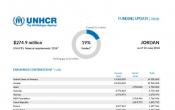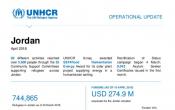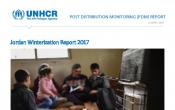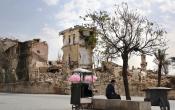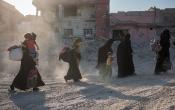Jordan
Operation: Jordan
Location
{"longitude":36,"latitude":31,"zoom_level":7,"iso_codes":"'JOR'"}
By clicking on the icons on the map, additional information is displayed.
Key Figures
| 2017 year-end results | |
| 526,280 | refugees were provided with medical consultations |
| 56,900 | families received cash assistance for winter |
| 38,530 | refugees received legal assistance |
| 32,460 | refugee families received monthly unconditional cash grants |
| 7,570 | refugees had their cases submitted for resettlement |
| 4,800 | best interest assessments were conducted for refugee children |
| 2018 planning figures | |
| 32,230 | households will receive cash grants |
| 5,000 | best interest assessments will be conducted |
| 1,700 | survivors of sexual and gender based violence will receive psychosocial counselling |
| 100% | of people of concern will be registered on an individual basis |
Latest Updates and Related Links
People of Concern
5%
Increase in
2016
2016
| 2016 | 720,812 |
| 2015 | 689,053 |
| 2014 | 672,930 |

[["Refugees",685197],["Asylum-seekers",35615]]
Loading ...
Jordan
< Back
2017
{"categories":[2013,2014,2015,2016,2017,2018],"budget":[367.56731878,307.65103446,328.87751632,318.80353781,277.212605641,274.89660652],"expenditure":[234.03438702,206.68124577,208.74308994,218.32880034,238.50705437,null]}
{"categories":[2013,2014,2015,2016,2017,2018],"p1":[367.56731878,307.65103446,328.87751632,318.80353781,277.212605641,274.89660652],"p2":[null,null,null,null,null,null],"p3":[null,null,null,null,null,null],"p4":[null,null,null,null,null,null]}
{"categories":[2013,2014,2015,2016,2017,2018],"p1":[234.03438702,206.68124577,208.74308994,218.32880034,238.50705437,null],"p2":[null,null,null,null,null,null],"p3":[null,null,null,null,null,null],"p4":[null,null,null,null,null,null]}
Loading ...
CHOOSE A YEAR
- 2014
- 2015
- 2016
- 2017
- 2018
Operational context
In 2017, the refugee population in Jordan remained relatively stable, increasing by some 17,000 people by the end of the year. The more restrictive border policy adopted after mid-2016 contributed to the limitation of new arrivals.More than 45,000 Syrians, 80 per cent of whom are women and children, remained living in makeshift settlements at Rukban site, near the north-east border with the Syrian Arab Republic (Syria), many of whom have stayed there for two years with little or no assets. The humanitarian situation of these people remained critical with families living in a vulnerable situation with little access to food or other basic services.
The majority of the 81 per cent of refugees residing outside of camps continued to live below the Jordanian poverty line, equivalent to $100 per month. Following commitments made at the 2016 Supporting Syria and the Region conference on livelihoods and education, the Government made progress on both, having issued and renewed more than 83,000 one-year renewable work permits cumulatively between 2016 and 2017. In addition, an enrolment of more than 126,100 Syrian refugee children was reported for the 2016-2017 scholastic year. Work permits for Syrians continued to be free of charge for an extended period and access to employment in the agricultural and construction sectors was facilitated without the need for sponsorship by one specific employer.
UNHCR continued its advocacy with the Government on the principle of non-refoulement. Despite a surge in refoulement to Syria in January and February, the monthly deportation figures subsequently dropped significantly from 2016 with a total of 2,370 Syrian refugees deported in 2017.
Funding for assistance to the non-Syrian population of over 80,000 refugees, mainly from Iraq, continued low, while basic cost of living and vulnerability remained high.
Population trends
By the end of 2017, Jordan hosted close to 737,500 refugees and asylum-seekers, an increase by some 17,000 people when compared to figures from the beginning of the year. Close to 89 per cent of people of concern were from Syria, followed by some 9 per cent of Iraqis, and a total of 53 other nationalities.Key achievements
The prolonged challenge of more than 45,000 Syrians stranded at the north-east border was a priority throughout the year. In 2017, the UNCT concluded a humanitarian aid delivery in January and initiated another distribution in May which was halted on 15 June due to challenges related to crowd control. In total, 35,000 people were assisted. A Health Clinic was operational during the year, and hundreds of life-threatening cases were temporarily admitted to Jordan for treatment.Monthly unconditional cash grants were provided to 30,000 vulnerable urban Syrian families through cost-effective, multi-agency implementation. Additional 46,700 vulnerable urban Syrian families (more than 200,000 individuals) were assisted with cash assistance as part of the winterization programme.
In 2017, solar plants were opened in Azraq and Zaatari refugee camps, the first of their kinds in the world.
To support increased access to work, the Zaatari Office of Employment, the first employment office in a Syrian refugee camp, was opened in August 2017.
Unmet needs
- Due to limited funding, UNHCR was only able to treat the most vulnerable people and medical emergencies under its medical referral system.
- The Community Support Projects were not implemented as, to be significant for the community, they require solid groundwork and networking over a period of time; a missed opportunity for fostering the harmonious coexistence between refugees and hosting communities. The same applies to protection interventions that need long term planning, with substantial consequences for sexual and gender-based violence and child protection activities.
- In 2017, UNHCR was unable to support additional beneficiaries with cash-based interventions, resulting in an estimate 2,200 non-Syrian households continuing to live in extremely vulnerable situations.
Working environment
The number of Iraqi, Somali, Sudanese and Yemeni people of concern being registered with UNHCR in Jordan continues to grow. The protection space continues to shrink, with access to territory being severely restricted, illustrated by the growing number of Syrians at the Berm between Jordan and Syria, and humanitarian assistance increasingly limited, particularly in the health and food security sectors. The Government of Jordan has, however, made significant progress in enhancing access to documentation, reduction of risk of statelessness (i.e. some 70,000 Syrian children obtained birth registration since the beginning of the crisis) as well as ensuring access to education for all refugee children as well as employment rights and work permits for Syrian refugees.As Jordan is not a signatory to the 1951 Refugee Convention, cooperation between UNHCR and the Government of Jordan is framed by a Memorandum of Understanding. The 2016-2018 Jordan Response Plan, which represents the national chapter of the Regional Refugee and Resilience Plan, focuses on both refugee response and resilience and development programming, with UNHCR leading the refugee response component.
Key priorities
UNHCR will continue to advocate for access to territory, the right to seek asylum, the principle of non-refoulement, family unity, and access to livelihood opportunities. UNHCR will also support the Government in ensuring protection in accordance with international refugee protection principles. Inter-agency coordination will remain at the core of the refugee response with an already well developed network of working groups and thematic task forces. Among them, the refugee response established innovative coordination fora regarded as a good practice in the region and at global level and that are being replicated in other locations (i.e. Task Force on Tertiary Education, Protection from Sexual Exploitation and Abuse and so on).In the event of funding shortfalls, 7,200 families will not be assisted through cash-based interventions. Health care and winterization assistance will also be affected. If funding for non-Syrian refugees is limited in 2017, UNHCR will focus its interventions on building and strengthening community-based protection mechanisms for a sustainable response.
